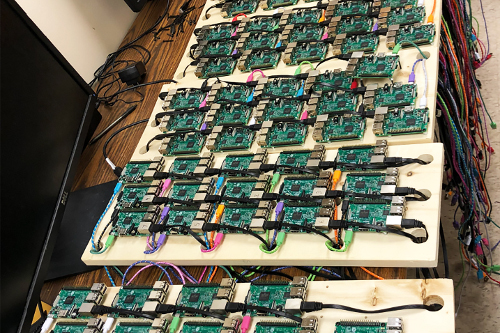Communications of the ACM
Students Build Supercomputer Cluster from Raspberry Pi Boards

Doctoral student Amin Amooie and other students worked on the Buckeye Pi supercomputer in Assistant Professor Joachim Moortgat's garage.
Credit: Joachim Moortgat / Ohio State University
"We're geeks, and we're motivated."
That's how Amin Amooie, a doctoral student in earth sciences at Ohio State University, explained his team's efforts to build the supercomputer they've dubbed "Buckeye Pi."
They are just learning how to write computer code for scientific simulations, he says, so it doesn't make sense to test their code on full-scale academic supercomputers.
That's why they set out to make their own.
Buckeye Pi is a platform for students to learn how to develop efficient, scalable computer code for research in the sciences.
And, with 128 circuit boards and 512 processors, it's also the most powerful student-built supercomputer ever made from off-the-shelf Raspberry Pi circuit boards.
Last month, Amooie described Buckeye Pi at the American Geophysical Union meeting in New Orleans.
The versatile tools offered by the Raspberry Pi Foundation in the United Kingdom inspired the project, Amooie says. The foundation sells low-cost, modular computers about the size of a deck of cards, and helps students learn how to use them to build their own electronics. The design is extremely flexible. One Raspberry Pi could operate a toy car, a video game console, or a simple computer vision system, for instance.
With cables and DIY computer rack included, the parts to build the Buckeye Pi system carried a price tag of roughly $7,500. That's five times less than a computer cluster purchased from a store, and only a tiny fraction of the hundreds of millions of dollars that a typical supercomputer would cost, says Joachim Moortgat, assistant professor of earth sciences and Amooie's adviser at Ohio State. The funding to develop Buckeye Pi came from the university's Office of Energy and Environment and the Alumni Grants for Graduate Research and Scholarship.
"Obviously, Buckeye Pi will not be competitive with million-dollar computers, but it will allow us to develop and test algorithms quickly and cheaply. Then, we can run a few larger simulations on commercial supercomputers," Moortgat says.
The project began a year ago, when Amooie faced the same problem as a growing number of students in the sciences.
"I have always wanted to test approaches to large-scale problems, learning things that can be used for real-world applications," he says. "That meant running really detailed simulations, and also learning how to write code for parallel computing."
He began the long process of learning how to code and adapting the code to suit simulations in his area of research: fluid flow in porous media. (Think: recovering oil and gas from the ground, or storing carbon dioxide in deep geological formations, or just following the flow of water in a riverbed.) It didn't make sense to request time on a supercomputer every time he wanted to test a small change in the code.
Amooie joined with undergraduate student Connor Basile, who majors in physics. They gathered in Moortgat's garage to drill holes in wooden planks and build their own computer rack from scratch, complete with a passive cooling system.
"This is real science, right? It's supposed to be fun," Amooie says.

Part of the Buckeye Pi supercomputer cluster.
The full cluster will be used for earth science simulations, but Moortgat has additional future application in mind.
"We'll eventually allow remote access to individual nodes," he says. "The idea is that students can use the Raspberry Pis remotely, even from a smart phone or tablet. More than 100 students will be able to run simulations simultaneously."
They also plan to expand Buckeye Pi for hands-on activities to educate K-12 students and the general public on challenges in energy and the environment.
The final rack design will be on wheels, Moortgat says, so the team can take Buckeye Pi on the road.
No entries found